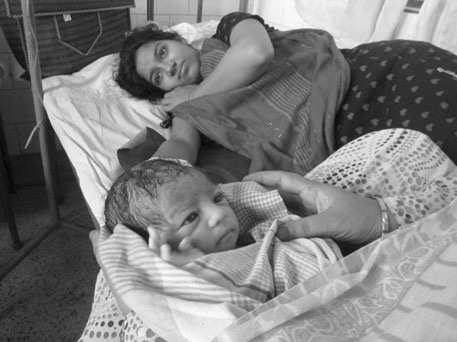Japan's Official Development Assistance White Paper 2010
(2) Health, Welfare, and Population
A large number of people living in developing countries do not have access to basic health services that are usually available in developed countries. As immunization and sanitation have not been set in place, more than 8.8 million children under five years old die annually due to causes such as infectious diseases, nutritional disorders, and diarrhea (Note 11). Moreover, more than 360,000 pregnant women lose their lives every year due to the lack of emergency obstetric care by skilled birth attendants like midwives.
Conversely, in line with its continuing steady rise, the world’s population is expected to reach 9.2 billion people by 2050 (Note 12). In general, among the developing countries there continues to be a tendency for poor countries to have a higher population growth rate, which leads to poverty, unemployment, food shortages, underdeveloped education, and environmental deterioration. From this perspective, maternal, newborn and child health care, reproductive health (Note 13) including family planning, and HIV/AIDS control, which can have an enormous impact on population issues, have become pressing challenges.
<Japan’s Efforts>
At the G8 Kyushu Okinawa Summit in 2000, Japan took up the issue of infectious diseases as one of its main themes for the first time in the history of the summit meetings. In 2005 Japan formulated the Health and Development Initiative (HDI), which aims to contribute to the achievement of the health-related MDGs. Under HDI, Japan has taken a comprehensive approach that includes fighting against infectious diseases, maternal, newborn and child health care, and strengthening health systems. It has also provided support that takes into consideration coordination with sectors that are closely related to health, such as water and sanitation and basic education. Moreover, Japan takes initiatives to tackle HIV/AIDS, tuberculosis, and malaria through the Global Fund to Fight AIDS, Tuberculosis and Malaria (the Global Fund). As of July 2010, Japan has contributed about US$1.29 billion to the Global Fund.
Regarding maternal and child health, Japan supports the fostering of healthcare professionals working on the front lines, improves and provides equipment for obstetrics facilities, and carries out initiatives related to improving the quality of emergency obstetric care in order to improve the health of women during pregnancy or parturiency. It also works to improve access to medical institutions by developing infrastructure, disseminate Maternal and Child Health (MCH) Handbooks which incorporate the perspective of continuum of care, disseminate medical checkups for women during pregnancy and parturiency, and reduce child mortality and morbidity through providing health management support for pregnant women. Regarding family planning, Japan provides support for efforts like educational activities and the distribution of contraceptives for preventing unwanted pregnancies and premature births, focusing on education for adolescents in particular.
At the G8 Hokkaido Toyako Summit in July 2008, Japan raised the importance of this comprehensive approach and forged consensus among the G8. It also announced the Toyako Framework for Action on Global Health (Note 14) by the G8 health experts. At the G8 Muskoka Summit in June 2010, under the Muskoka Initiative for strengthening assistance for maternal and child health in which progress has been slow among the MDGs, Japan announced that it will provide an additional assistance of up to ¥50 billion, equivalent to approximately US$500 million, over five years beginning in 2011.
The HDI ended in March 2009, and in 2010, Japan established the new Global Health Policy for the 2011– 2015 period — the deadline to achieve the MDGs.
Notes:
(11) Source: UNICEF, State of the World’s Children 2010, 2010.
(12) Source: UNFPA, 2009 State of World Population, 2009.
(13) Refers to sexual and reproductive health.
(14) This document is a proposal to G8 leaders from the G8 health experts. It was hailed in the outcome document of the G8 Hokkaido Toyako Summit.
●Bangladesh: Safe Motherhood Promotion Project
In Bangladesh, many pregnant women still die during pregnancy and childbirth. Reasons include: a low percentage of women receive prenatal checkups and few childbirths take place in the presence of skilled midwives. To improve the health of pregnant women, this project gives advice to central and local health authorities, aims to improve the services provided by medical facilities, and strives to create a community support structure for women and children. In the district where the project was implemented, the percentage of pregnant women with obstetric complications who received emergency obstetric care improved from 17.8% in 2006 to 55.6% in 2009. The activities supported by this project became widely known as the ”Narsingdi” model — the name taken from the name of the district — and was incorporated into the national policy as a means to revitalize community clinics.

A baby born by Caesarean section and the baby’s mother at a hospital participating in the project (Photo: JICA)
